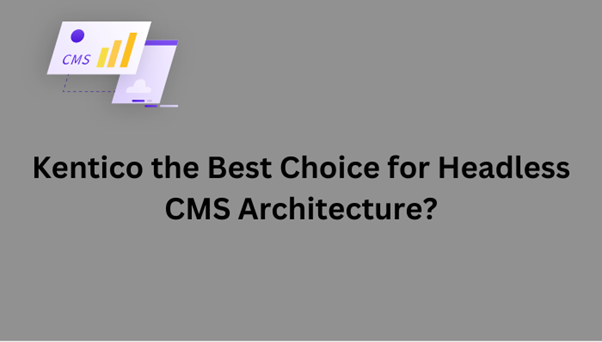As the modern digital landscape continues to reform, businesses are increasingly looking for CMS that can easily build websites and integrate with different integrate with a variety of front-end technologies.
Kentico, a leading CMS and digital experience platform provider that emerged as a top choice for organizations seeking a headless CMS architecture.
In this blog, we will illustrate how Kentico is the top-notch headless CMS Architecture, focusing on its robust features, benefits and how it competes with other solutions.
Headless CMS Architecture Explained
Before we dive any further, let’s get to know about what is Headless CMS Architecture.
A headless CMS keeps the content management separate from the presentation layer, whereas traditional CMS monolithic platforms couple them. This type of architecture enables organizations to control content in a single place and serves it across different front-end applications via APIs.
This separation greatly increases the flexibility to re-use content in various channels including websites, mobile apps, and digital signage. As a result, businesses are looking to integrateheadless CMS development services to streamline content management and delivery across all platforms.
Why Kentico is the Right Choice for Headless CMS Architecture?
There are several benefits to using Kentico, and this is why it is most preferred and well-known atthe current time.
Now let us have a look at ten functionalities due to which we can consider Kentico as one of the better options for implementing headless CMS architecture:
1. Flexible Content Delivery
Kentico delivers content to all channels like websites, mobile apps, and IoT devices. By creating the separation between content management and presentation, Kentico offers APIs that make it easy for developers to fetch that data wherever they need and display it, making a robust solution with flexibility in building different digital experiences.
2. Omnichannel Consistency
Kentico is a true powerhouse for omnichannel content management, giving organizations complete control of the versions that are live on every channel and ensuring messaging at any touch point remains consistent. Again, the same API helps illustrate that users get a streamlined brand experience because the content is created using rich text capabilities only once so it can be dynamically rendered in any application — website or otherwise.
3. Built with the API-First Approach
Kentico uses the API-first approach in its headless CMS providing very powerful RESTful and GraphQL APIs. These APIs help to easily integrate with other systems like CRM, ERP, or any custom applications. A Kentico development company can help make sure these APIs are used efficiently for interconnecting and synchronizing data between different platforms. The Kentico collaboration allows for personalized, integrated solutions that automate business processes to access critically important functions faster. It means better use of the powers of Kentico’s API endpoints and thus a more integrated digital ecosystem.
4. Flexible Content Modelling
Kentico offers powerful content modeling capabilities to design custom types and structures of your content. This flexibility is particularly useful for headless CMS environments, where content has to be manageable and structured for consumption by different types of applications or channels.
5. Scalability and Performance
The headless architecture of Kentico is created to cater to the high volume required content intensity easily. Decoupling content management from delivery makes sure better performance is delivered, and you can scale up without affecting the usage of your editor to manage content.
6. Advanced Security
Kentico’s headless CMS provides various security features like role-based access controls and encryption of data. It strengthens security by providing separation of the content management layer from delivery, which prevents unauthorized attempts to access or threaten your content.
7. Front-end development is customizable
Kentico’s headless CMS gives developers the ability to use any front-end technology or framework like React, Angular, or Vue. Another approach is to use the imperative API provided by React (i.e. ReactDOM, so you can write your user interfaces) in combination with JS and go wild! This not only gives the flexibility to build custom and more interactive user experiences using modern development practices & technologies.
8.Content Personalization
Kentico has implementations to support content personalization which enables businesses to deliverthe right experience based on user interest, preference, and behavior. This personalization can extend to every digital channel using a headless CMS approach, improving the impact and relevance of content.
9. Multi-Channel Content Management
Using Kentico’s headless CMS, you will be able to manage content across all digital platforms from one location. This capability makes it much easier to manage different channels using a single source for all content while minimizing redundancies and maintaining consistency.
10. A Better Developer Ecosystem
Kentico has a strong community of developers, and vast resources in documentation, forums & support This integration system helps developers with Kentico headless CMS so that they get the best support and help from APIs to bring it into free action within other systems or technologies in no time.
This demonstrates Kentico´s considerable properties to operate as a headless CMS solution that is flexible, scalable, and secure enough for modern content management and delivery requirements.
Conclusion
In essence, Kentico as a headless CMS comes out very well and is promising to cater to good quality digital experiences irrespective of touchpoints. With its extensive feature set, flexibility, and scalability, Kentico is particularly well-suited for enterprises looking to optimize content management as part of a broader digital transformation strategy.
Enterprises can use Kentico’s comprehensive capabilities to manage and deliver content across websites, mobile apps & IoT devices efficiently. The platforms with the API-first way, reaching content models as needed, and having strong security practices can make integration very easy while managing your content effectively thanks to its fast nature.
The Kentico team is also committed to tools and resources that make life easier for developers, which creates a fruitful environment of support from the surrounding community. Combined with the gradual development and innovation of features on the platform, Kentico has cemented itself as a frontrunner for organizations who want to stay ahead in their respective digital markets.


